Fixture for a sink: appointment, features, installation
Fastening for mortise washing is a necessary part for fixing the sink bowl to the table top during its installation. This type of mounting fixtures greatly simplifies the process of installation and subsequent dismantling of kitchen sinks, and we want to consider it in more detail.

Sink fittings
Purpose and features

Mortise and overhead sinks almost crowded out all other models of kitchen sinks from the market due to their beauty, practicality and ease of use. This type of plumbing is best suited for installation in a modern countertop, which involves the maximum integration of all appliances in the overall interior ensemble of the room.
One of the features of such an installation is that on the surface and in the visibility zones there should not even remain traces of fixing fittings, gaps, cracks and other technological details. To fulfill this requirement, you need a hidden and reliable fastener that can not only imperceptibly, but also with sufficient effort to attract the sink bowl to the surface of the table top.
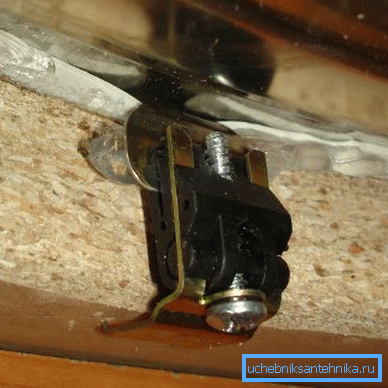
Of course, plumbing manufacturers took care of such a fixture, because the options "do it yourself" and "modify the file" have long been irrelevant, and modern products should be staffed to the maximum.
Consider the device fastener:
- The product consists of two parts and a clamping screw;
- The lower part is attached to the sink apron in special grooves or holes;
- The upper part rests on the tabletop, crashing into it with special teeth;
- The parts are interconnected with a screw, twisting which we can adjust the distance between them. If the lower part is fixed at the sink and the upper part rests on the tabletop, then reducing the distance we will press the sink to the table;
- Parts have a hinge, and the upper part can be bent relative to the bottom. During installation, this feature allows you to first bend the teeth inward, insert the sink into the hole in the tabletop, and then again bend them back and rest against the board.
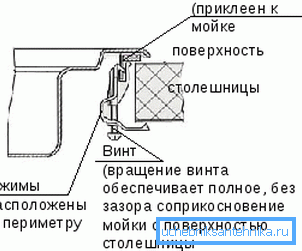
The product may consist entirely of metal (tin, stainless steel, galvanized) or have plastic inclusions. All-metal clips are considered more reliable.
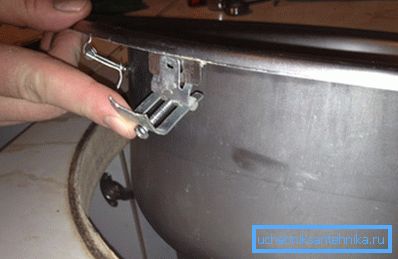
Note! Even in the case of the all-metal clamp body, the screw should be tightened only with your hands, as the thread on the washer is weak and is easily broken by a screwdriver.
Installation without clamping
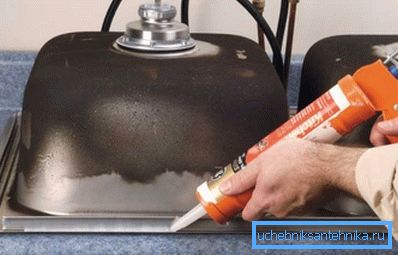
There are situations when fasteners are lost or not suitable for the thickness of the table top. In this case, you can do without them, although it is highly undesirable.
There may be options:
- Use glue or sealant for fixing.;
- Make a mount yourself from parts for installation of gypsum boards.

Since the sinks are superimposed on the hole and rest on the table top from above, all the operational loads and the resulting forces tend to press the bowl even more. The only point is the gap between the sides and the board.
If we put the sink on the glue (silicone sealant, epoxy resin, etc.) and press the bowl with the help of the load for the time of hardening, as a result, the gap will be minimal and the fixation will be secure.
Note! The main problem of glue is the impossibility of quick and easy dismantling of the sink if necessary during the repair or replacement of the mixer or other parts of the structure.
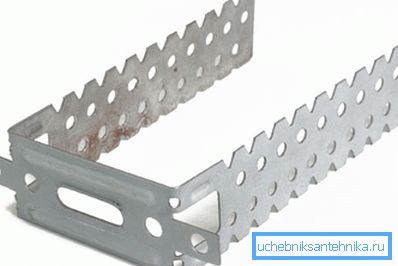
You can take remote mount for GCR profiles and cut it into two parts. The antennae are fastened to the mount at the sink, and through one of the holes we insert the screw and attach it to the tabletop at an angle. Thus, an attracting force arises, and the mount comes out reliable and durable.
Note! Screw the screw can only be in a wooden tabletop. Composite, polymer and stone products for this method are not suitable, it is possible to mount on the dowel.
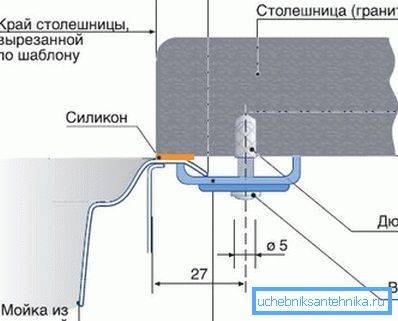
The price of fasteners is very small, so there is no point in reinventing the wheel in this case. It is much easier to buy suitable fasteners and save time and effort.
Installation

It is very easy to install fasteners on the shell and fix the bowl with your own hands with it.
The instruction will be short and visual:
- On the shell of the shell we find special grooves or ears for fastening the clamps;
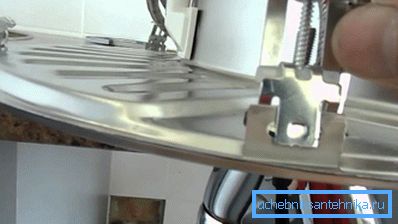
- We insert into the grooves the corresponding parts of the clamps;
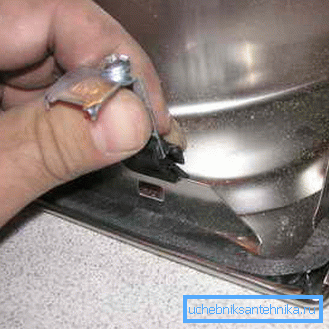
- Bend the upper part of the mount closer to the bowl, insert the sink into the countertop;
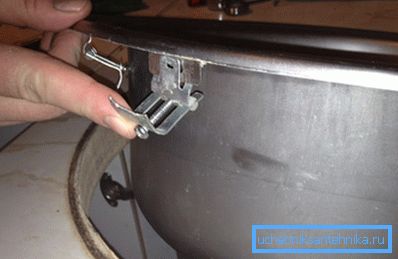
- Using a screwdriver, tighten all the screws in succession. We try to keep the bowl pressed evenly and gradually.
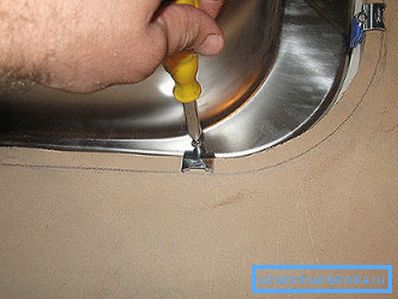
Note! An indicator of sufficient clamping force is silicone squeezed out from under the side. Remove residue with a rubber spatula or cloth.
Conclusion
Reliable fastening of the kitchen sink is the easiest to implement with a special clip. These clamps are usually supplied with a mortise shell. The video in this article will help you to better understand this topic.